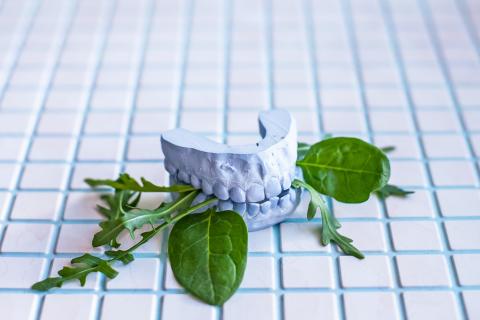
Creating natural dental enamel using biomaterials
Jessem Landoulsi, a physico-chemist and member of the Materials Science Institute, is an academic professor at the Reactive Surface Laboratory (LRS) at Sorbonne University. Working within the Sorbonne University Alliance and in partnership with the Technical University of Compiègne (UTC), this researcher has developed a biomaterial that mimics the nature chemical and the mechanical properties of natural tooth enamel. His goal: to make a durable dental implant.
You have studied the interfaces between the inorganic materials and the biological systems. On what aspect is your research focused?
Jessem Landoulsi: My work includes fundamental studies that enables us to understand, for example, how a molecule of biological interest, such as a protein or peptide, behaves on the surface of the material, or how a biomolecule is involved in the production of a mineral material such as bone. I also investigate as closely as possible the biological reality. I study, for example, mineralized biological tissue (such as bone and cartilage) and the associated calcification phenomenon, such as osteoarthritis. I use surface characterization techniques to that enable me to probe information at the nanometer scale.
This area, for which I work in close interaction with biologists, plays a central role in particularly in the development of implants or prostheses. Because when you introduce a new material into the body, proteins from the organism will hang on its surface. And the phenomena of inflammation, rejection, and other issues which can appear, strongly depend on the way in which they are organized on the surface of this material.
Tell us how the Toothmimic project was created and to win the call for projects from the Institute of Materials Science (Imat)?
JL: I took advantage of a CNRS delegation to start a collaboration with the biomechanical and bioengineering laboratory (BMBI) of UTC. Working with Karim El Kirat, a colleague in this laboratory, we developed a biomimetic approach to better control the mineralization process, that is to say the formation of calcium phosphate (main constituent of bone and teeth).
We were inspired by what happens in nature by using enzymes. The use of these proteins capable of accelerating the reactions made it possible to manufacture materials that are difficult to make with conventional chemistry. It has thus enabled us to develop a calcium phosphate whose properties are very close to those observed in natural calcium phosphate.
Building on this success with Christophe Egles, a biologist at UTC, , we wanted to apply this method to make a mineralized structure similar to dental enamel.
What are its objectives?
JL: The degradation of teeth, which results in the formation of cavities, results from a long and complex interaction between bacteria that produce acid and fermentable carbohydrates (sugars) in a particular environment (teeth, saliva). Because enamel, unlike bone, does not regenerate, the use of dental implants is common. But it fails in 5 to 10% of cases (and up to 20% of cases in smokers) generally due to a bad association between tooth and implant.
To improve this implant/tooth interface, our objective is to use the enzymatic approach that we have developed to manufacture a material whose composition and morphology resemble that of natural dental enamel: a prism-like structure, devoid of cells and mainly composed of fluorinated calcium phosphate.
We will then look at how the interface between the implant and the tooth will evolve over time and whether our solution is durable or not.
How are you working with UTC for this project?
JL: I established strong links with UTC and in particular with colleagues from the BMBI laboratory who welcomed me during my two years of CNRS delegation. As an associate member of this laboratory, I interact regularly with them, which greatly facilitates the advancement of this type of interdisciplinary project. Access to the equipment of our two respective laboratories (BMBI/LRS) is facilitated for our doctoral students who can now do experiments both on the Pierre and Marie Curie campus and at UTC. With Toothmimic, the collaboration between LRS1 and BMBI, already supported by the directors of the two units, will hopefully be strengthened.
Finally, we will be able to draw on UTC's long experience in industrial property to ultimately patent our approach, if our results prove conclusive.
What does the creation of a materials science institute at Sorbonne University bring you?
JL: The Imat first offered support for our theme. Thanks to thesis funding from the institute, we had the chance to select a highly motivated candidate who has already worked in the field of biomineralization.
Internally, the institute enables us to join forces. We are working more and more on multidisciplinary research projects, and the fact that the institute brings together different specialties around materials, lets us quickly find a partner for our projects.
Externally, the institute gives better visibility to our research and enables us to position ourselves in relation to other international institutes in materials science.
The Materials Science Institute
At the heart of strategic sectors of the economy and omnipresent in society, materials constitute a fundamental field of study and research.
The Materials Science Institute brings together major players in this field and positions itself at the interface of several disciplines: chemistry, physics, Earth sciences, heritage and engineering.
To meet the major societal and industrial challenges, this interdisciplinary institute strengthens education, research and international collaborations in the energy, sustainable development and health sectors.
To meet the challenges that face our contemporary society but which do not belong to any science in particular, the Sorbonne University Alliance has set up several institutes and initiatives. which bring an interdisciplinary approach and offers an opportunity to compare knowledge and experience, both in research and in education.
1 LRS (Sorbonne University/CNRS)
